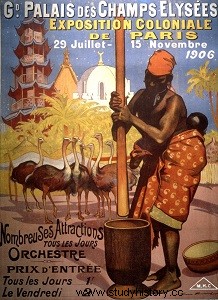
Let's take a look at the exhibition. Here, at random:
The flag of Madagascar. It rises in its purple splendour. Inside, in the large and high room, dioramas reconstruct with strange accuracy four of the most typical sites of the “Red Island”:Majunga, Antsirabé, Tamatave and Lake Alaotra. The panorama lets you guess the streets lined with bazaars, the alleys festooned with indigenous huts, the avenues lined with huge mango trees, and finally the magical Ivoulouïne garden.
Somalis - A.-O.F. - Cameroon. After visiting the pavilion of the Coast of Somalis with its minaret adorned with rustic balconies, here is the place which occupies the center of the Indochinese section. But the eye is first drawn to the constructions of the A.-O.F., which erect their walls of fire and whose pavilions occupy an area of four hectares. We find there a palace, a city district, villages in the bush and the forest, a lakeside city, a mosque and a camp sheltering one hundred and fifty blacks somewhat out of place under the Parisian sky. The building that serves as the official palace is a faithful reproduction of the great mosque of Djenné, a Sudanese city located on the Bani River, a tributary of the Niger. The interior has nothing to do with a mosque, there is an interior courtyard surrounded by a gallery.
Around this open the stands of the colonies forming the federation of the A.-O.F. :Dakar, where we see a plane hovering over the new port, Guinea, Ivory Coast, Dahomey, Sudan, Upper Volta and Mauritania. In each of the stands, dioramas, exhibits combine, with the graphics, to inform us about the evolution of the States of the federation. But local life is elsewhere. It swarms on the forecourt of the palace, where a large space is reserved for exhibitions, dances and simulacra of combat. It is also found in the narrow streets of the old town of Djenné reconstituted with its red mud houses It is still in the shadow of the saddles worked by Senegalese and Sudanese jewelers, the weavers of Ségou, of the upper Côte-d' Ivory and Dahomey.
African territories under mandate:Togo and Cameroon. We can see, from a distance, the high, slightly rounded thatched roofs. When you approach, here are the walls with
geometric gray and black decorations, the peristyles supported by slender and slender wooden columns. In the showcases of the central pavilion, there are engraved ivories, black earth pottery, ebony horns, molded and chiseled copper statuettes.
In the hunting pavilion, near of a luminous frieze, are reconstituted scenes of the jungle. Fortunately, we were able to use the trophies of the great explorer Bruneau de Laborie, who died in 1931, killed by a lion.
Angkor and Indochina. Before entering the avenue that leads to the admirable reconstruction of the temple of Angkor Wat, an avenue lined with stone ramps and naga, these snakes with human busts, we left behind us the pavilion of Laos, near from the shore of Lake Daumesnil.
Laos is represented by a village. There, a library has been set up next to a pagoda and houses sacred books. A portico and a few huts complete the set. Tonkinese pass by, trotting minutely, a chant from the Orient drags along...
In front of me, twenty-five pavilions are erected for this section of Indochina alone:pavilion of the forest, of hunting and fishing, the offices of the press, the pretty and radiant building lined with rare woods and precious trinkets, devoted to the administration.
La Cochinchine, which has no no national architecture, presents itself under an aspect of modernism which bothers us a little... Fortunately, a rice field surrounds it. Here and there, the ceramics and bronzes of Bien Hoa, the sumptuous red and gold altars of the ancestors attest that art has not given up.
Tonkin is the work of the architect Sabrier. Beyond a portico, a courtyard develops amusing shops. At the back, the dinh has been erected, the vestibule of a temple, supported by heavy columns of red wood between which is the altar of the ancestors, guarded by wax figures, and which shines among long black shelves covered with sentences painted in gold.
Let us now cross the Sacred Way, the backbone of the Indochinese section of the exhibition. For Annam and Cambodia, it is the royal palace of Hué that inspired the architect Devé. The two light buildings interpret one the Guoe tu giam or college, the other the Thai-mien or dynastic pavilion. In the latter, the father of the current ruler appears seated on his throne. Around him his dresses, pink, golden,
the color of the moon and the sun, are lined up as if on parade.
The Cambodian pavilion, topped by golden elephant trunks, looks like a parade junk anchored on a river, Blue or Yellow. Mr. Groslier, director of the arts in Cambodia, adorned it lovingly. In the centre, from the vestibule, royal insignia reproduced in gold, damascened steel and enamels, shine in a showcase; on the left, an ethnographic, geographical and economic section; on the right, art, ceramics, precious fabrics, weapons.
We move forward, the heavy doors have closed and there, in semi-darkness, pierced by veiled lamps and red, a sheepish religious assembly. Torsos bent, spines broken, bodies thrown to the ground, hands raised in a gesture of imploration. In the background, detached on a hard blue fabric, the golden idol, on the right, and, on the left, the squatting monks, their faces hidden behind small screens held in their hands, freeze in an attitude of ecstasy. , incense sticks burn with acrid wisps, ritual chants with plaintive tones exhale from who knows where.
At the end of the pier, vanguard of the temple, two towers stand up, low and square, bearing a carved Buddha on each side, reproduction of two Angkor Thom motifs. Shrines? Secret retreats of a monk? I opened the door and saw an electrical transformer...
